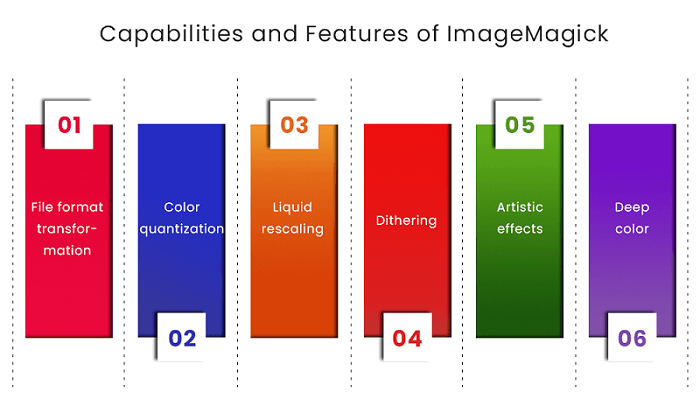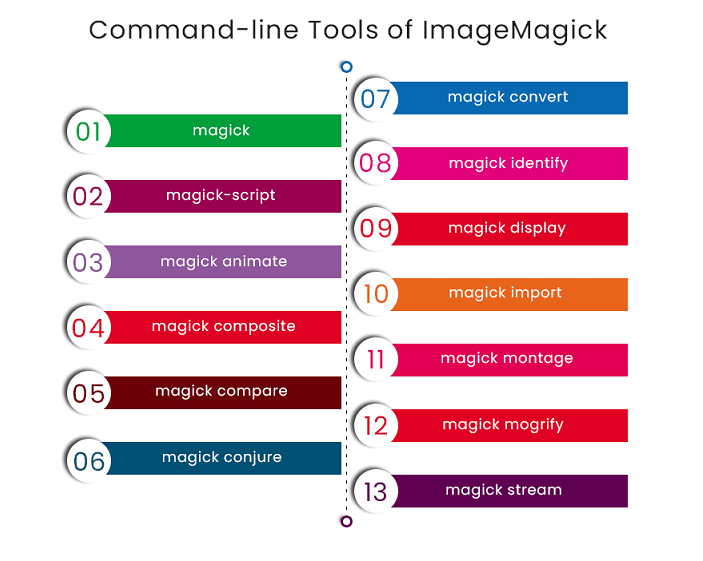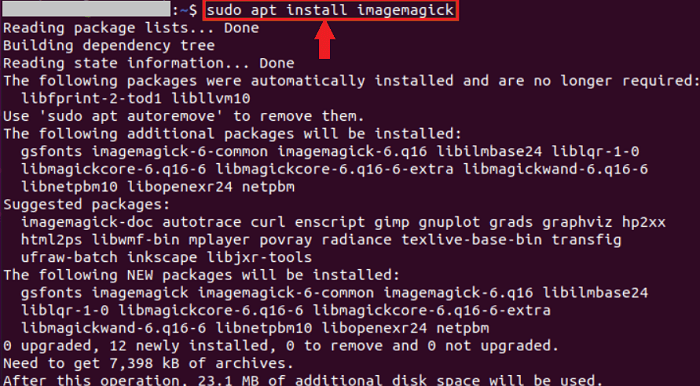Install ImageMagick UbuntuIntroduction to ImageMagickImageMagick is an open-source and free cross-platform software suite to display, create, convert, modify, and edit raster images, prescribed from the command line as magick. It was developed by John Christy in 1987 and can write and read over 200 image file formats. ImageMagick and its components are extensively used in many open-source applications. ImageMagick is used for creating, editing, composing, or converting digital images. It can write and read images in a range of formats (200+), including TIFF, EXR, DPX, PDF, SVG, HEIC, WebP, GIF, JPEG, and PNR. It can transform, shear, distort, rotate, mirror, flip, and resize images, adjust image colors, use several special effects, or draw Bezier curves, ellipses, polygons, lines, and text. ImageMagick is a free software offered as a ready-to-run binary distro or a source code that we may use, distribute, modify, and copy in both proprietary and open applications. It is shared upon a derived Apache 2.0 license. ImageMagick uses more than one computational thread to enhance performance. The latest release of ImageMagick is 7.1.0-43. It runs on Android OS, iOS, Mac OS X, Windows, Linux, and others. History of ImageMagickImageMagick was developed by John Christy in 1987 when operating on DuPont, converting 24-bit images to 8-bit images, so they could be shown on almost all screens during the period. It was freely published in 1990 when DuPont admitted to sending copyright to ImageMagick Studio LLC, which is still the project maintainer organization currently. It was announced that ImageMagick had a susceptibility from which an attacker can run arbitrary codes over servers that utilize the application for editing user-uploaded images in May 2016. Security experts adding CloudFlare researchers noted the actual use of the susceptibility in active hacking attacks. The security flaw was because ImageMagick called backend resources without properly checking to make sure the file names and paths were free of wrong shell commands. The susceptibility didn't affect the distributions of ImageMagick that added a correctly configured security policy. Capabilities and Features of ImageMagickMainly, the software consists of many command-line interface utilities that manipulate images. ImageMagick doesn't have a strong graphical user interface for editing images as GIMP and Adobe Photoshop but does contain- for UNIX-like operating systems- a common native X Window GUI (known as IMDisplay) to render and manipulate API libraries and images for several programming languages. The program applies magic numbers to recognize image file formats. Several programs, such as vBulletin, phpBB, MediaWiki, and Drupal, can apply ImageMagick to make image thumbnails. Also, ImageMagick is used by many other programs, like LyX, to convert images. ImageMagick contains a fully developed Perl binding known as PerlMagick, as well as various others: TclMagick (TK/Tcl), RMagick (Ruby), PythonMagick (Python), IMagick (PHP), MagickWand for PHP (PHP), PascalMagick (Pascal), MagickNet (.NET), NMagick (Neko/Haxe), L-Magick (Lisp), JMagick (Java), Magick++ (C++), ImageMagickObject (COM+), ChMagick (Ch), MagickWand (C), MagickCore (C), or G2F (Ada). 
File format transformationOne of the thoroughly-implemented and basic aspects of ImageMagick is its capability to accurately and efficiently transform images between distinct file formats (it applies the convert command to achieve it). Color quantizationIn an image, many colors can be decreased to an arbitrary number, and it is done by balancing the most outstanding color values available among the image pixels. The related ability is the posterization artistic effect, which also decreases many colors illustrated in an image. The distinction between it and idea color quantization is that the final palette in the standard quantization is chosen based on a prominent weighting of available colors in the image; posterization makes the color palette smoothly distributed around the spectrum illustrated in the image. Every final value is one that was in the real image with standard color quantization, the color values in the posterized image might not have been available in the real image but are in between the real color values. Liquid rescalingLiquid rescaling support was added in 2008. This feature permits, for instance, rescaling 4:3 images into 16:9 images without altering an image. DitheringGood control is given for the dithering that appears during sharing and color alterations, including the capability to produce halftone dithering. Artistic effectsImageMagick contains a range of features and filters intended to make artistic effects:
Deep colorThe Q8 version supports up to 8 bits-per-pixel elements (8-bit grayscale, 24 or 32-bit RGB color). The Q16 version supports up to 16 bits-per-pixel elements (16-bit grayscale, 48 or 64-bit RGB colors). OpenCLImageMagick can apply OpenCL to utilize an accelerated graphics card for processing. OtherThe following are a few other aspects of ImageMagick which are listed and explained below:
ImageMagick Related SoftwareImageMagick 5.5.2 has a fork, i.e., GraphicsMagick. It was created in 2002, focusing on the cross-release programming API stability and command-line options. GraphicsMagick came up as an outcome of incompatible differences in the group of developers. ImageMagick DistributionIt is cross-platform and executes on Unix-like and Microsoft Windows systems, including FreeBSD, Haiku, Solaris, Android, iOS, macOS, and Linux. The source code of the project can be compiled for several systems, including MorphOS and AmigaOS 4.0. It has been run upon IRIX. Command-line Tools of ImageMagickImageMagick contains several command-line utilities to manipulate images. Most of us are probably addicted to editing images once at a time using a graphical user interface with such programs as Photoshop or GIMP. But GUI isn't always good. Suppose we wish to dynamically process an image through a web script, or we wish to use similar operations to various images or repeat a particular operation at distinct times to the different or same image. The image processing utility of the command-line is correct for these operations. The command-line tools of ImageMagick exit with the 0 status if the arguments of the command-line have an accurate syntax and no issues are encountered. Expect the 1 status and a descriptive message if any exception occurs, like improper syntax, an issue writing or reading an image, or other problems that avoid the command from successfully completing. Here is a description of all command-line tools: 
Sub-commands are also supported with ImageMagick version 6 for compatibility:
Development of ImageMagickTypically, the ImageMagick functionality is used from the command-line, or we can use the aspects from programs specified in our favorite language. We can select from several interfaces. We can also use ImageMagick to create or modify images automagically and dynamically with the language interfaces. We can select from many language interfaces:
Installing ImageMagick in UbuntuImageMagick is a very famous open-source software suite used for editing bitmap images. In this article, we will discuss how we can install the latest release of ImageMagick in Ubuntu. Installing ImageMagick with the APT Package RepositoryWe can install the current stable release of ImageMagick from the APT package repository of the official Ubuntu. First, we need to update the APT cache repository of our system by running the below command: After updating the package repository of our system, we can install ImageMagick with the help of the below command: 
Type the "y" button and press the "Enter" button to grant extra disk space and proceed with the installation process. We need to verify the installation by entering the below command once ImageMagick is successfully installed in our system.
Next TopicInstall Latex Ubuntu
|
 For Videos Join Our Youtube Channel: Join Now
For Videos Join Our Youtube Channel: Join Now
Feedback
- Send your Feedback to [email protected]
Help Others, Please Share










